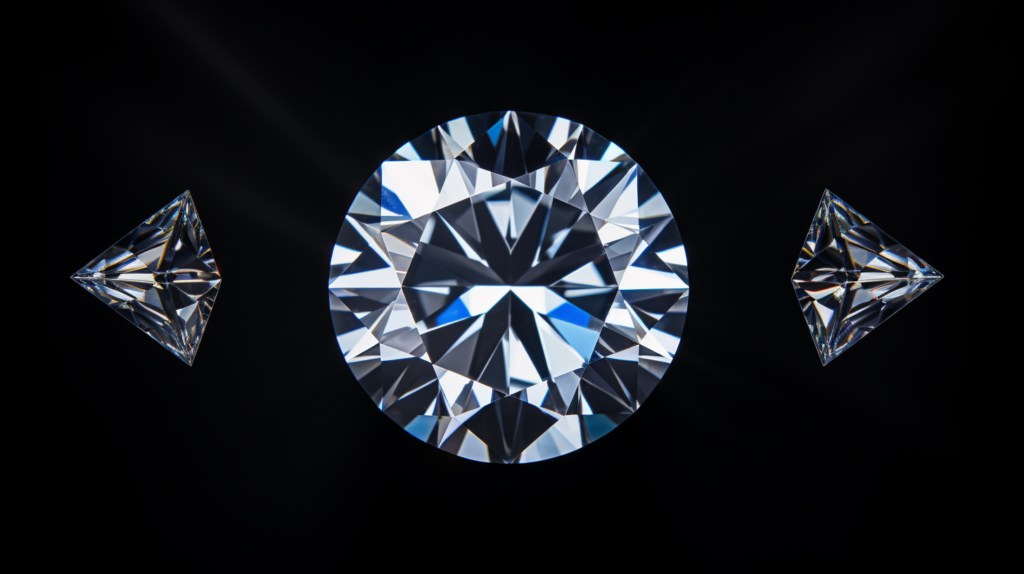Welcome to our guide on the Holloway Cut Advisor (HCA), a powerful tool in the diamond industry.
We’ll take you on a journey through the strengths and weaknesses of the HCA, sharing practical insights along the way.
Developed by expert Garry Holloway, the HCA aims to enhance the cut quality of diamonds.
So, let’s dive in and explore this A Guide to the Holloway Cut set by BrighterGuide.
Related article: Unveiling the Beauty of F-Color Diamonds
Key Takeaways
- The Holloway Cut Advisor (HCA) is a tool developed to evaluate and enhance diamond cut quality, emphasizing light performance.
- While the HCA offers insights into a diamond’s optics and cut, it only analyzes 17 of the 57 facets, missing factors like girdle thickness and symmetry.
- For a comprehensive assessment of a diamond, it’s essential to use the HCA in combination with other optical tools and data from reputable retailers.

In this post, we’ll explore:
A Brief History of the Holloway Cut Advisor
We will now delve into the history of the Holloway Cut Advisor (HCA) and its development in the diamond industry. The HCA was created by Garry Holloway, a renowned expert in the diamond industry. Holloway recognized the importance of light performance in diamonds and set out to develop a tool that could assess the quality of a diamond’s cut.
The HCA software was designed to evaluate various aspects of a diamond’s cut, including the angles of the crown and pavilion, as well as the optical symmetry and light leakage. By analyzing these factors, the HCA can determine the diamond’s potential for light return and brilliance.
One of the best things about the HCA is its rejection ability. By comparing diamonds with similar grading certifications, the HCA can identify stones that fall short in terms of optimal optics. Customers can reject diamonds that do not meet their needs.
Keep in mind that the HCA has flaws. A diamond has 57 facets, but this tool only looks at 17. It does not look at the girdle thickness, polish, or symmetry ratings. Additionally, the HCA is most applicable to round brilliant cut diamonds.

An Overview of the Software’s Strengths
One of the software’s strengths is its ability to accurately assess a diamond’s light return, scintillation, spread, and fire. This is crucial in determining the overall beauty and visual performance of a diamond.
Here are some key strengths of the Holloway Cut Advisor (HCA) software:
The HCA software takes into account various factors to determine the grade and Total Visual Performance of a diamond. This comprehensive evaluation helps in making informed decisions about the diamond’s quality.
An HCA score below 2 indicates desirable qualities in terms of light return and optical characteristics. This can be used as a quick initial filtering tool to narrow down options.
The HCA software allows for a comparison of similar stones based on grading reports. This helps in identifying poor performers that fall short of optimal optics.
The software provides average values for diamond proportions, allowing buyers to assess how a particular diamond compares to the ideal standards.
Actual diamond images can be used to further evaluate the stone’s performance and optical characteristics, giving buyers a more intimate understanding of the diamond they’re considering.

Using the HCA as a Quick & Easy Rejection Tool
The HCA can be a helpful tool for quickly and easily rejecting diamonds that don’t meet our desired criteria. As diamond shoppers, we understand the importance of finding the perfect diamond for our purchase. With the HCA, we’ve a reliable diamond selection tool that allows us to filter out diamonds that may not meet our standards.
By utilizing the HCA, we can compare similar stones based on their diamond grading reports. The HCA score helps us find diamonds that do not have the best optics, so we can rule them out of our consideration. Choosing the diamond will take less time and work because of this.
One of the key factors the HCA considers is the table percentage, which affects the diamond’s light return. Diamonds with excellent cut grades and optimal table percentages will reflect light beautifully, creating broader flashes of light known as pin flashes. The HCA helps us identify diamonds that may lack these desirable features, allowing us to reject them and focus on diamonds that meet our requirements.
It is important to remember that the HCA has its limits, even though it can be used to quickly and easily reject someone. It only analyzes 17 out of the 57 facets of a diamond, and it doesn’t consider girdle thickness, polish, or symmetry ratings. To make a more informed decision, further examination using idealscope or ASET data is recommended.

Even the Software Has Its Weaknesses -What You Need to Know
The HCA tool can provide useful information, but it has limitations. Some important considerations:
Analysis of only 17 out of 57 facets: The HCA tool focuses on specific aspects of a diamond’s cut, such as light return and scintillation. However, it doesn’t take into account other important factors like girdle thickness, polish, and symmetry ratings. This means that the HCA score may not provide a comprehensive assessment of a diamond’s overall quality.
Exclusion of broader flash characteristics: The HCA tool is limited in its ability to reveal scintillation patterns or broader flash characteristics of a diamond. These features contribute to a diamond’s overall beauty and can greatly impact its visual appeal. Therefore, relying solely on the HCA score may not give you a complete picture of a diamond’s potential brilliance.
Limited applicability to round brilliant cut diamonds: The HCA tool is primarily designed for round brilliant cut diamonds. While it can still provide some insights for other diamond shapes, its effectiveness may be reduced. If you’re considering purchasing a different diamond shape, it’s important to take this limitation into account.
Not a sole basis for purchase decision: It’s crucial to understand that the HCA score shouldn’t be the sole basis for making a purchase decision. While it can be a helpful initial filtering tool, it’s advisable to use other optical examination tools, such as idealscope or ASET data, to further assess a diamond’s performance.
Importance of additional information: To make an informed choice, it’s recommended to consider other factors like videos and scope data provided by reliable retailers. These additional resources can provide a more comprehensive understanding of a diamond’s appearance and help you make a confident decision.

Conclusion: Usage And Results of the HCA
Overall, we found the usage and results of the HCA to be informative and valuable in assessing diamond cut quality. The Holloway Cut Advisor, or HCA, serves as a guide in the evaluation of a diamond’s performance. By analyzing factors such as light return, scintillation, spread, and fire, the HCA provides a comprehensive assessment of diamond quality. The HCA score, with a desirable range below 2, helps in identifying diamonds that exhibit optimal optics.
However, it’s important to note that the HCA shouldn’t be the sole basis for making a purchase decision. While the HCA offers a useful initial filtering tool, it has its limitations. The analysis is focused on only 17 out of the 57 facets, excluding important factors like girdle thickness, polish, and symmetry ratings. Additionally, the HCA doesn’t reveal scintillation patterns or broader flash characteristics, which are important considerations in diamond analysis.
To ensure a thorough evaluation, it’s recommended to use other optical examination tools in conjunction with the HCA. Ideal scope or ASET data can provide further insight into a diamond’s performance. Furthermore, videos and scope data provided by reliable retailers can offer a more intimate understanding of a diamond’s appearance and quality.
Sources
BrighterGuide is dedicated to providing accurate and relevant information as you explore the wonderful world of diamonds and jewelry. To this end, our writers refer to primary information sources in building each article that appears on this website. These include, but are not limited to, published news articles, government portals, research papers, and more.
- Holloway Diamonds. (2023, August 24). Holloway Cut Adviser – Holloway Diamonds. https://www.hollowaydiamonds.com.au/holloway-cut-adviser/
- Holloway Cut Advisor | HCA Tool. (n.d.). https://www.pricescope.com/tools/hca